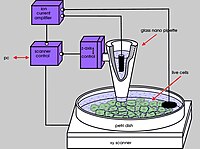
Photo from wikipedia
An automatic fluorescence detection system based on a pipette tip-type biosensor was developed to detect a prostate-specific antigen (PSA), a biomarker for prostate cancer. Fluorescence-based immunosensing for PSA detection was… Click to show full abstract
An automatic fluorescence detection system based on a pipette tip-type biosensor was developed to detect a prostate-specific antigen (PSA), a biomarker for prostate cancer. Fluorescence-based immunosensing for PSA detection was performed by a sandwich assay with a fluorescence-labeled antibody or its fragments. A small protein A-immobilized reaction plate was placed on a plastic pipette tip (referred to as a Biologi tip). For automatic PSA detection, a programmable dispensing robot equipped with a photodetector was used to suction the samples (i.e., capture antibody, antigen, primary antibody, and reporter molecule), incubation, and migration of the pipette tip to the detection port to measure fluorescence. The use of Fab-fragments and F(ab′)2-fragments as fluorescently labeled detection antibodies in a sandwich assay resulted in higher signal-to-noise ratios than those for whole IgG. The PSA detection in normal human serum using an Alexa Fluor 647-labeled F(ab′)2-fragment secondary antibody showed that t...
Journal Title: ACS Omega
Year Published: 2019
Link to full text (if available)
Share on Social Media: Sign Up to like & get
recommendations!